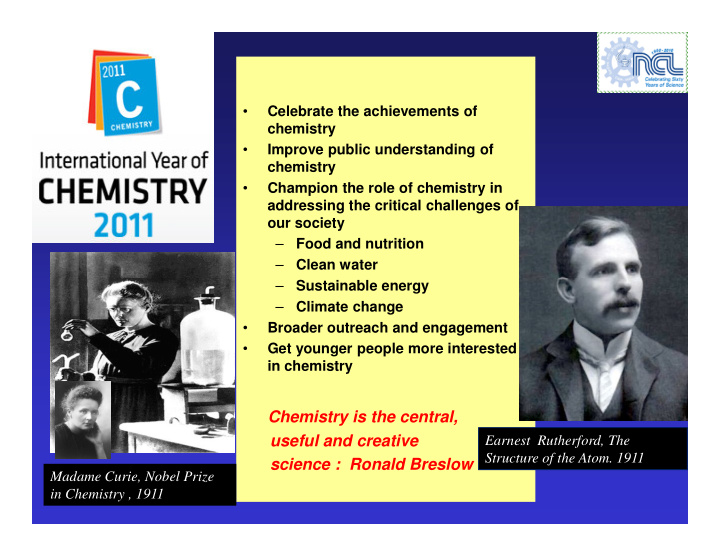



Celebrate the achievements of • chemistry Improve public understanding of • chemistry Champion the role of chemistry in • addressing the critical challenges of our society Food and nutrition – Clean water – Sustainable energy Sustainable energy – – Climate change – Broader outreach and engagement • Get younger people more interested • in chemistry Chemistry is the central, useful and creative Earnest Rutherford, The Structure of the Atom. 1911 science : Ronald Breslow Madame Curie, Nobel Prize in Chemistry , 1911
THE AGES OF HUMAN KIND Human Civilization has been marked by several ages, which are all material based � - Stone Age - Stone Age - Bronze Age - Iron Age ( Steel. Aluminum) - Polymer Age ( Carbon based materials) -Age of Elements ( Silicon, Uranium, Lithium, Indium, Gallium etc)
CHEMISTRY CREATES MATTER THAT NEVER EXISTED BEFORE eg. PLASTICS, DETERGENTS, DRUGS, INSECTICIDES, ETC. Creative Central Designs structures Underpins many other with new and scientific disciplines unique properties Biology, geology, material science Useful Provides many materials essential to everyday life, knowledge to better human, veternary and plant care, better food, environment
Hennig Brandt of Hamburg (1630 -1710) The Alchemist in Search of the Discoverer of Phosphorous Philosopher’s Stone ( Joseph Wright, 1771) The chemical reaction Brandt stumbled on was as 3- , as sodium follows. Urine contains phosphates PO 4 phosphate (i.e. with Na + ), and various carbon-based organics. Under strong heat the oxygens from the phosphate react with carbon to produce carbon monoxide CO, leaving elemental phosphorus P, which comes off as a gas. Phosphorus condenses to a liquid below about 280°C and then solidifies (to the white below about 280°C and then solidifies (to the white phosphorus allotrope) below about 44°C (depending on purity). This same essential reaction is still used today (but with mined phosphate ores, coke for carbon, and electric furnaces). The phosphorus Brandt's process yielded was far less than it could have been. The salt part he discarded contained most of the phosphate. He used about 5,500 litres of urine to produce just 120 grams of phosphorus. If he had ground up the entire residue he could have got 10 times or 100 times more (1 litre of adult human urine contains about 1.4 g phosphorus ).
CHEMICAL REVOLUTION : EARLY BEGINNINGS Annalen der Physik und Chemie, 88(2), 253- 256 (1828) Freidrich Wohler (1800 – 1882)
Chemistry creates its own object. This creative power, similar to that of arts distinguishes it fundamentally from the other natural and other natural and historical sciences Marcellin Bertholet, 1860 (1827- 1907)
CHEMICAL REVOLUTION : UNDERSTANDING CHEMICAL STRUCTURES � The Theory of Chemical Structure (1857-58) Auguste Kekule � Structure of Benzene published in (1829 -1896) Bulletin de la Society Chimique de Paris, 3(2), 98-110 (1865)
CHEMICAL REVOLUTION : UNDERSTANDING CHEMICAL STRUCTURES The Tetrahedral Nature of Carbon ( La Chimie dans l’espace, 1874 ) Jacobus van’t Hoff (1852-1911) First Nobel Prize in 1901
THE DAWN OF THE CHEMICAL INDUSTRY: THE MANUFACTURE OF BAKELITE � Baekland set out to discover a substitute for Shellac, then wholly supplied by India to the world � In the process he made the first man made material, heralding the age of plastics, a discovery considered as plastics, a discovery considered as revolutionary � Heat resistant and insulating � Baekland named his new material Novolak � He founded a company called Bakelite Corporation in 1910 to manufacture the product US Patent 942, 699, December 7, 1909
THE DAWN OF THE CHEMICAL INDUSTRY: THE MANUFACTURE OF BAKELITE Leo Baekland (1863-1944) When asked why he chose to work in the field of synthetic resins, he replied” to make money”
SYNTHETIC POLYMERS �������� • ������������� ������������������� ������������������ ��������������������� ��������������������� • • ����� ������������ ��� ������� !����� • !���������������� � "##����� $��������
THE MOLECULE OF LIFE : DNA
�������&�!�����������%�������'�##��((( $�����%�������� �����%�������� ������#������������ ���#���������������* • • ��������������������� %���������*������������������ • • ��*�#��*����� )��������*�#��*����� • ������������ �����������������
�������������������������� ���������������������� ������������������������� ��������������������� �����������������������
�������� !�"�#�$�%��&����� '%(�!���"�!)! �� $���#�!�
*�+�&����&�'! %����(�����#�"%�$�%����# � �'*�!'%(���*�!��, +��������-�.����������� • ����������������/���������� ����01����.���������������� ���������2��������/��������� �����������������������3 ����/��������������������� • ����/��������������������� • ������������������ ����/��������������������� • ��������������.�������� ��������������.�������� ����������������������������� /��3���������������
��������������� .����������������� ������ ��������������������������� ����������������������� �������������4��������3� ������ ���������� ������ !��������4������������� !��������4������������� ������.�� ������������������������ )�������������������.������� �������.�������.�/��������� �������������4���������������� ����������/����� Other materials : Silicone rubber ( foot bed), sulfochlorinated Polyethylene ( toe drag) ������������������������
Recommend
More recommend